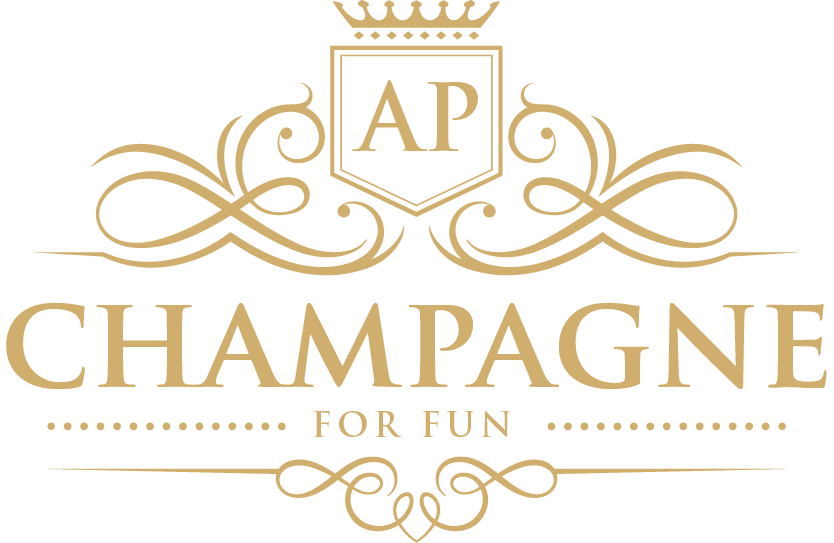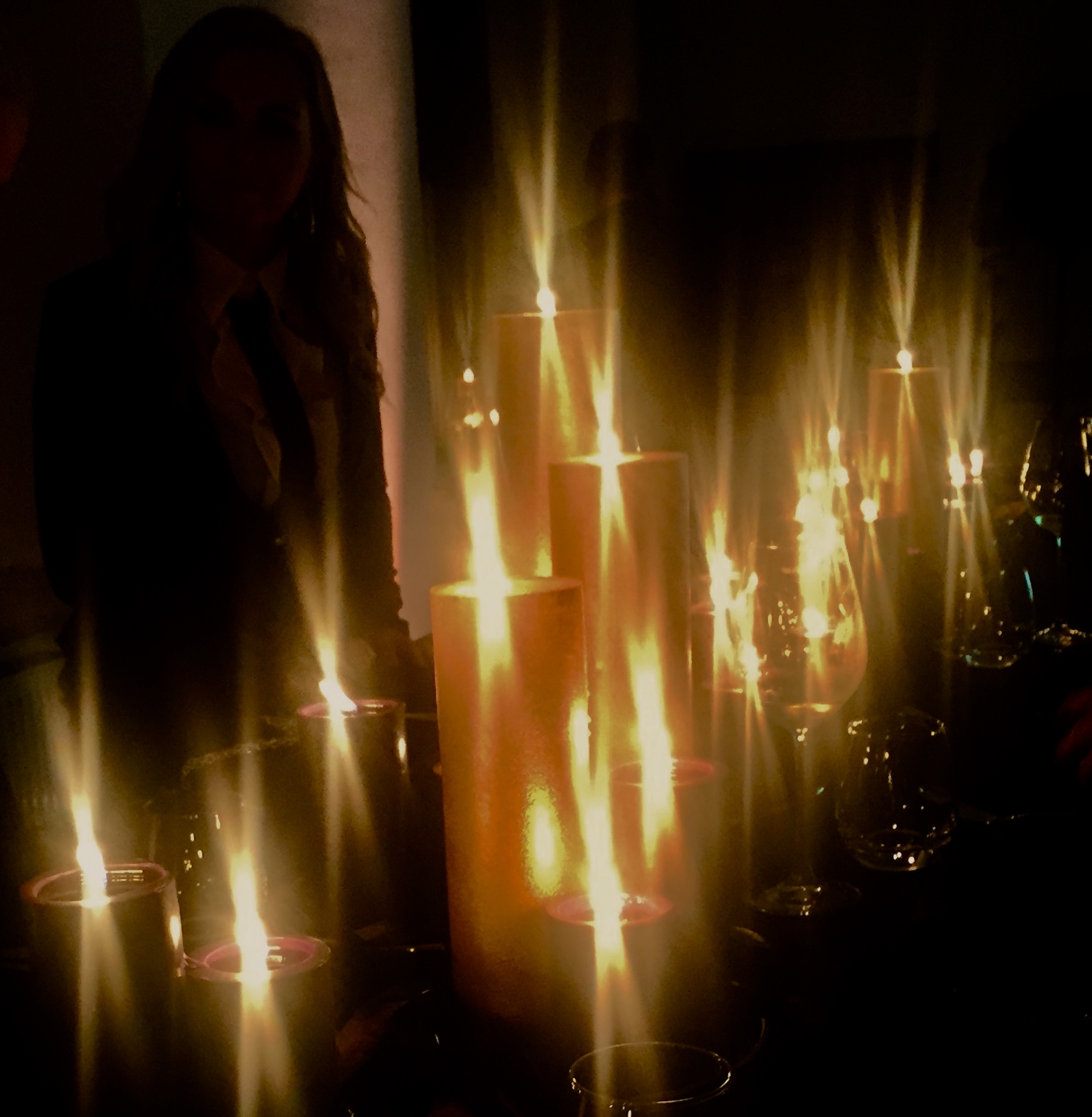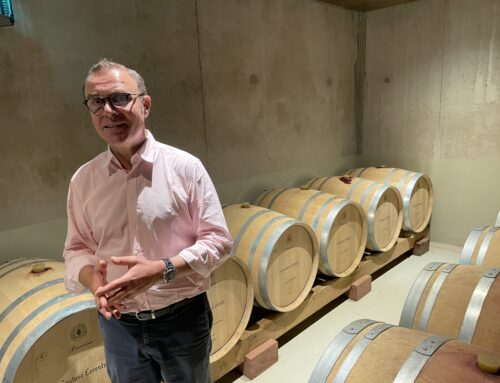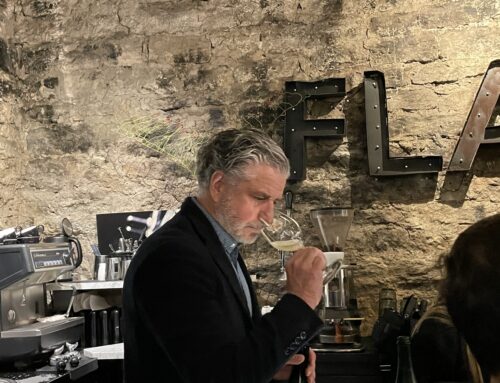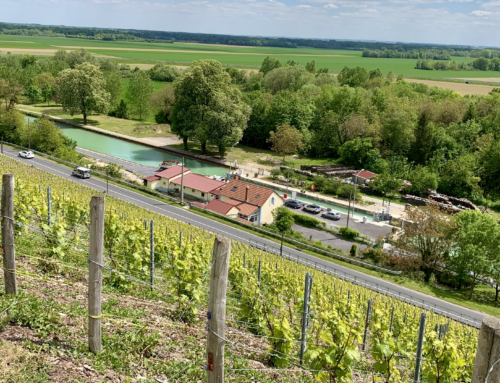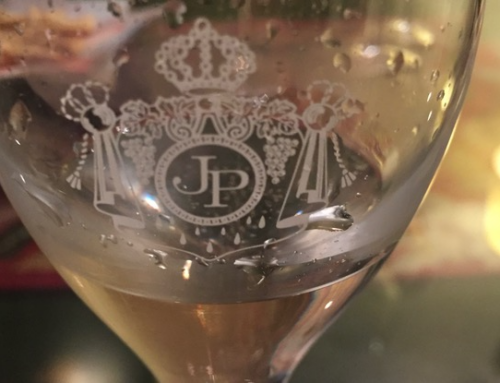The sound of high heels on a frozen cobblestone street
I find that Dom Pérignon champagne is the same story for all vintages and from P2 to P3.
A very well told story. A story, aged for at least 16 years, that transports you to tomorrow.

But on this night, tomorrow is still far away. A few rapid footfalls can be heard on the frozen cobblestones of Tallinn’s Old Town, a sliver of moon can be glimpsed between gable roofs, and from time to time a cat meows contentedly, having caught a mouse in a leaf pile under the ancient trees. No hooves clattering or swords clanking here. Just a few rapid footfalls, like gold coins landing into a barrel, plink plink plink. Yet the careful listener can discern a darker thump in between footsteps, like a coin in a leather pouch is falling into a wooden chest. A barely audible thunk. Followed, pensively, by another thunk. And again and again. Lights flare and are extinguished in the windows of the houses lining the empty street. Somewhere in the dimly lit Raeapteek apothecary shop around the corner nearby a phantom-like pharmacist’s apprentice is brewing a love potion to win the heart of the merchant’s daughter. From the depths of the darkness on Pikk Street, a couple emerge, the woman in a fur cape, veil over her eyes. The gentleman has a scarf obscuring his face. Still the clicking of high heels and the quiet thunk thunk. A silent watchman standing in a beam of lantern-light by a large carved oak door with copper ornaments bows and opens the door. The door moves without a creak, only a quiet sigh. Even before the couple hurrying into the vestibule disappear from view, a bit of the warm glow from within falls on the street, along with the light of flickering torches. The heavy door opens another four times that hour, always with that quiet sigh, and four other couples quickly go up the stairs, in silence.
The night is full of secrets, the air is quivering with looks and expectations
Entering the secret meeting place, those arriving blink their eyes still used to the darkness. The capes and scarves are tossed aside and Hanna, a beautiful young woman with a distinguished bearing, says in a mellifluous voice: Hello, I’ll be your hostess tonight.
A quick kiss on the cheek of Hannes, his skin still cold from the autumn air. No, we were not blindfolded, but expectations were heightened as we proceeded through the Old Town by night to the meeting place having been given only the barest of information. The invitation, the meeting place and Dom Pérignon itself – everything honed, kept secret down to the final detail. All this makes those entering feel special, chosen.
In the corner of the hall, His portrait is being painted. The barefoot artist seems to be from the same school as the Estonian impressionist Konrad Mägi – the background on which He is portrayed has a very Mägi-like feel. Photos are allowed, but no uploads to Instagram, not yet. Tonight is a secret.
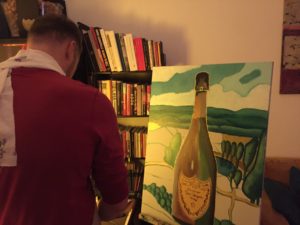
Two masters, one of them is Dom Perignon.
Martin Saar painting the portrait of Dom Pérignon
Amuse-bouche
The eyes of those gathered in the dining hall start alighting on the plate for longer and longer intervals. No sauerkraut or wiener schnitzel will be served tonight. Only amuse-bouche. I remember when I saw that phrase for the first time on a menu, I wondered what the difference was between an amuse-bouche and hors-d’oeuvre and how they went together.
Hors-d’oeuvre is a word that conjures up canapés with caviar and – I cannot help it – my Soviet past means that hors d’oeuvre is translated automatically to zakuski. French chefs would hardly approve of that. Both are savoury nibbles, but the Russian word that survived Soviet times means something you chase vodka with. In this cold northern country under the influence of its big eastern neighbour, zakuskahas managed to make itself at home over the centuries. Entree or starter does not sound half as tasty sounding as zakuska.Sorry – appetizer. Sorry – starter. Such ugly words should not go together with anything edible. Even the great undying resentment over the communist occupation does not strip the word zakuskaof the possibility that you are reaching out your hand for something delicious.
These are just some quick linguistic digressions. There are neither zakuskior starters here. Silver Saa serves amuse-bouche. One amazing bite. It’s interesting that it could be translated into Estonian as suupiste, meaning something you stick in your mouth. But for me that word makes me think of fish sticks.
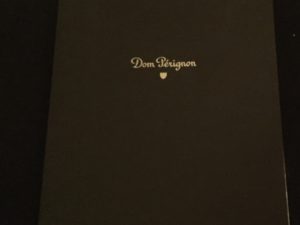
Dom Pérignon’s mysterious menu
Dom Pérignon’s mysterious menu
Amuse-bouche and reality snap into place. One bite that describes the whole world. A cep tartlet, marinated chanterelles, manchego. Not that amuse-bouche is the word that would occur to me to describe such a bite that sums up the world – not at all. Hannes is ready to assist with the menu, gradually coming to light from the darkness of secrecy. A tartlet is also a nibble that titillates the palate and our sense of language. A little tart that longs to grow up. Each time I bit into a tartlet, I have a pang of conscience. This time it’s not only the tartlet that is small; the chanterelles are also in their tender youth. I ask for their forgiveness.
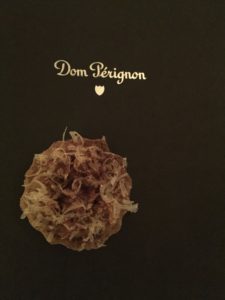
The small tartlett
The small tartlet
Manchego comes from La Mancha
The atmosphere in the dining hall is intimate, full of temptations and secrets. It wouldn’t be appropriate to get out a phone at the table to check out what or who is manchego. I can’t hide it, erudition falls short. Later I look it up: what tasted like sheep’s milk cheese and smelled like sheep’s milk cheese was indeed sheep’s milk cheese. The man, or sorry, cheese from La Mancha. Both deeply romantic and good company. You probably remember the line from the musical: Only one who attempts the absurd is capable of achieving the impossible. Exactly and yes. That’s the way it is. The pitch-black secrecy here in the Old Town can seem laughable because after all we are adult and responsible and run big companies and report to the tax board and Europe. What mysterious games. But in the morning light, you realize you’ve achieved the impossible. You’ve found the real Dom Pérignon, learned much about food, bubbles and your companion and dancing has electrified your whole body with energy. To open your computer and achieve the impossible. See what great twists of fate through Mitch Leigh’s musical a little Manchego in the night of this Nordic capital can summon forth. I realize that again the old Indian was right. My soul needs time to catch up to my body. Now we’re here and in the now and attention incarnate.
The monk Dom Pérignon is here
Prike has woven us into this story
Hannes pours a 2009 Dom Pérignon. The meeting between sparkling bubbles and glass is one of the many beautiful sights to behold in our world. The glass quietly fills with joy. Behind this joy are Dom Pérignon’s century-old experiments, the millennial miracle of nature in shaping the terroir, the cellarmaster, Richard Geoffroy, who is a more powerful mage than the apprentice at the Raeapteek that night centuries ago. And of course Prike Eesti. Words have a wondrous power to contain entire stories, people and worlds. Of course, tonight is Dom Pérignon’s night. But my eyes see Priit Kessa flickering quietly in that night. No, he isn’t really here. There’s no old monk, either. Yet they’re here and even participating in the conversation.
Hannes pouring Dom Pérignon vintage 2009
In actuality, Hannes is indeed the fixer, the organizer and the talker. He is like an ambassador or go-between.
A meeting with Hannes in the course of which I grew four sizes
Indeed, I know Hannes as an ambassador. Hannes is a person who could talk about many products but my ears prick up when he talks about a legend. When he talks about champagne. We met him for the first time in the champagne club of a piano bar. As it happened, the Estonian champagne club is made up of women. There are male visitors but the organizers and members are women. Why is that? I can’t say. Anyway, on the evening that we met Hannes, there were some finer champagnes on the shelves of the piano bar and the bar was full of beautiful women. For some reason, I manage to end up in social situations where my birth year is the lowest number. So I was spotted by Hannes in that champagne club. Anyhow, he bowed ravishingly toward me and asked: “Have you ever tried Veuve Clicquot?”. I wouldn’t have expected any better a question. I was a huge Veuve Clicquot fan by that moment. Above all, I was inspired by Barbe Nicole’s path as an entrepreneur. Hannes asked about the champagne right at the start of the evening, when the first flute of the champagnes to be tasted was being poured. I smiled a mild-mannered smile like a spring wind, it felt like I drew myself up to four sizes taller and answered: Not all that much. But 1998 Veuve Clicquot La Grande Dame brut rosé is, I find, contrary to critics’ poor 92 point rating, superb. But it’s a matter of taste, isn’t’ it?” This was how our friendship started. Maybe it just seems that way to me. Hannes is worth listening to and Hannes knows how to get you to listen.
Listening to Hannes’s suggestive voice, the corner of my mouth wants to break into a smile. How the “old lady” filled with air. Luckily, this was also the beginning of my conscious champagne education. The fact I happened to ask the right question quickly cemented my image as champagne expert. There was nothing to do but to adapt the real me to match the image of champagne sage. It seems to me that I’ve come a long way, with the help of ESA’s private sommelier school but there’s still a longer distance to go.
Dom Pérignon 2009 vintage and papaya – or a guava?
Dom Pérignon vintage 2009 is a pleasant surprise. What I remember primarily about 2009 was the very poor start to the growing season. Heavy rain. Nature wasn’t kind to the vines. It turns out the story had a happy ending. The harvest started on 12 September after a warm and mellow August.
At the instant that Hannes pours champagne into my glass, I pick up the scent of Cuba. The aroma that stayed with me after a trip to Cuba nearly half a century ago is very disorienting for me. It was in Cuba that I made my first acquaintance with papayas. On that trip, I didn’t think much of that big orange flesh with the black pearls for seeds. But it was no wonder as it was my first time out of the Soviet Union. The papaya smelled a little like a strawberry and a little like green grass. All of it came packaged in a wrapper of Cuban cigar smoke and sugar cane and my own excitement. And now I smelled the same sort of fragrance coming from a 2009 Dom Pérignon. I must have been making an audible sniffing noise, for my neighbour pulled back instinctively from me. I make the same sound again, stick my nose quite deep in the champagne glass. Cuba. Or papaya. I’m thinking it can’t be – a fruit with such an awful appearance can’t be what I smell now in this glass. Little by little I smell more commonplace – peach and nectarine, perhaps a bit of grapefruit peel. And something I don’t know. Like a halved pear on top of a strawberry bowl. Plus vanilla and brioche. I’m so long with my nose in the glass that I don’t dare claim I can discern the papaya fragrance anymore. I ponder buying a bottle to take home, slicing some papaya as an accompaniment and then I will see whether it really does smell like papaya or whether my olfactory sense is playing tricks on me.
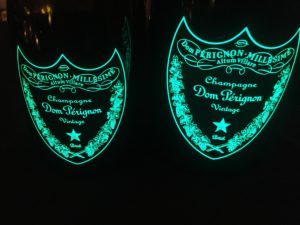
Dom Perignon
Dom Pérignon vintage 2009 tastes like silk
I totally lack patience with champagne. That means it takes a great effort by me not to simply swig the distinguished beverages that need to be decanted. The same goes for aroma. My nose wants to dive into the glass no sooner than the pourer has removed the bottle from the vicinity of the glass’ rim. Not exactly appropriate behaviour for those seeking more refined experiences. I know all this and admonish myself to be better. The taste of Dom Pérignon vintage 2009 is suitable for the atmosphere. Like silky secrets. Cobblestones under a thin rime of ice, torches casting a warm glow by a doorway, refined whispers and men’s air-gentle caresses on ladies’ knee or neck. All of the stronger emotions are kept visibly in check but all the more palpable for the restraint. The back of my hand accidentally grazes my partner’s shirt and at the same moment I taste the champagne: silk. Namely, not only the structure is silky but the taste of Dom Pérignon 2009 vintage is silky. Silk that is black as night, full of promises. The champagne starts telling its story and it flows over the terroir’s saltiness and bittersweet biscuit into the promises of the night ahead. Champagne is actually a very complicated partner, you can’t just dive into it, quaff it like water from a well in big gulps. You can’t drink champagne at all, truth told. Champagne and I, it’s a dialogue. At first you strike an acquaintance, then you listen to what you are told and the aftertaste usually determines your emotions for a long time.
The practice bottle is followed by a magnum
Hannes recommends leaving a drop at the bottom of the glass. Because a real champagne bottle, a magnum, is about to come to the table, joining the 0.75 l practice bottle. If you have a choice, opt for the magnum and you won’t be disappointed. A magnum is a suitable home for a champagne to mature and is the right size when there are at least two people to enjoy it. Yes, those who know add Churchill’s argument: A magnum is the right size for two gentlemen if one of them is not drinking.
A magnum of Dom Pérignon vintage 2009 offers everything that this evening’s first mouthful does. And much more. And more. Even more indulgent silk, an ever deeper velvet, sunnier fruits and endless brioche. Yes, life experience counts for something, too.
Looking at the plate, the menu must be consulted. Frédéric Vardon, chef of LE 39V in Paris, says beans pair well with champagne. I don’t like beans in any dish. Maybe at a beer-drinking picnic at the beach by the light of a bonfire, I’ll absent-mindedly pop a salted broad bean in my mouth, but as far as I’m concerned, that plant family could just as well stay the stuff of fairy tales where someone can climb up a beanstalk to heaven. In the company of my dear vegan friends, I will try to ingest an edamame or two, concealing a sigh. I like soy milk and those young soy beans do not really kill me. I have also picked at borlotti beans in Tuscany, accompanied by red wine, but ended up filing up on local bread instead. It’s clear that I can’t claim that my choices are exactly healthy ones. But goat cheese and watercress are something that get me to pick up the pace of my spoon. This appetizer, accompanied by a magnum of 2009 Dom Pérignon, changed my opinion of beans completely. I think I’ve been knocked so far from my original prejudice against beans that I might even order them voluntarily at LE 39V in Paris.
Bottles of Dom Pérignon with a burning label line up along the edge of the bar. The air in the dining area is brimming with positive emotions in half-tones.
Capes slide on to shoulders quietly, scarves are taken from the cupboard and Hanna leads us out into the autumn evening. Now at once, the clicking of ten matchstick thin stilettos supported by the steady thunk of boots supporting them, rings out on the cobblestones. The Old Town night is full of feelings.
The adventure continues in our next part.

Manufacturer: Moët&Chandon
Region: Champagne
